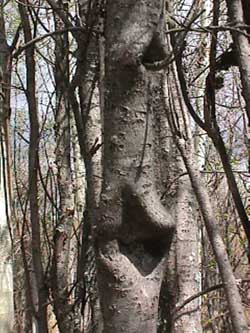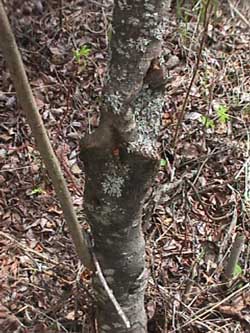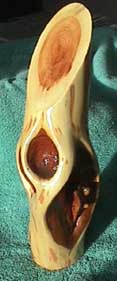
Why Make a Walking Stick? The best explanation I have seen on that is "In Praise of Walking Sticks" by Peter Salwen.
What is Diamond Willow? For detailed information about Diamond Willow, see Bob Gander's article, "What is Diamond Willow". See also "Creating Ridges In Diamond Willow," and "Making Diamond (Willow) Jewelry."
Tools/supplies you will need:
leather gloves
pocket/jackknife with short, sharp blade
sanding blocks with 80, 120 and 220-grit sandpaper; finer if you
like
Making a Diamond Willow Walking Stick will probably do two things:
1. Give you a deeper appreciation of what Nature offers
2. Give you a super-beautiful walking/hiking stick/staff which
will really make people take a second look.
These sticks make you want to hold them, stroke them, feel them, fondle them; they just "FEEL good." They make you "Bond" with them. I gave one to a friend and told him that. As we spoke, he replied, "that's what I'm doing right NOW." They sell for prices as high as $85 U.S. and sometimes more.
My brother and his wife have done a lot of hiking, such as the
Chilkoot Trail and they find their sticks indispensable. They
use them to struggle up steep grades and someday may have to use
one to beat off a hungry bear or an unfriendly dog. I hope not!

When to collect them:
I collect the "dead" ones when I find them and have
made a shoulder harness to carry them in the bush. As to the "live"
ones, I collect them only between May 15 and July 15 because during
that period the sap is running and they are very easy to peel.
Other times of the year, I mark the green ones with ribbons, to
collect them later.
Where to collect them:
Usually, near beaver dams and other wet areas. I've been told
that D.W. sticks from the cold north, such as Grande Prairie,
Alberta, Canada, where I live, are best; I cannot confirm that
this is true but I sure find some absolutely beautiful ones.
Here are a couple of pictures showing Diamond Willow still growing:


How to collect them:
I normally carry a machete and hack them off as low to the ground
as possible. I've been told that if you rip them out with the
roots, you might get a stick with a natural handle but have never
found that to be true. Back at the cabin I trim them with a saw
as needed, leaving them as long as possible.
Removing bark:
Some say that Diamond Willow must be left to dry for 6 months
before removing the bark, in order to prevent splitting/cracking.
I have not found this to be true for walking/hiking sticks, but
agree that it is probably true for the "large diameter"
pieces.
When you remove the bark from "green" or "live" sticks the stick is mostly white. The dead sticks may look nicer, with the brown wood rather than so much white color, but removing the bark is a lot of work. I use a pocketknife and wear leather gloves and use some kind of protection for wrists and lap. Knives tend to slip. I've cut myself many, many times.
 Sanding them:
Sanding them:
I use a Drum Sander from Roberts Studio in Sevierville, TN. Their
phone number is (423)428-8875 and they can send you a catalog
showing their "Flex Drum Sander" which runs US$29.95.
You can also email Jerry, there, at intarsia@icx.net.
I use the "80-grit" sanding sleeve first, then the 120 and lastly the 220-grit.
To clean the diamonds, I use the Dremel Motor Tool or similar; that is the most work.
I need the power tools because I have hundreds of sticks to sand. For purposes of a class where each person does one stick, hand sanding blocks are fine.
If you do your sanding indoors, dust might be a problem. Consider buying or constructing a dust collection system. At a minimum, wear a dust mask and sand out-of-doors.
Cleaning out and sanding the "diamonds"
is still a problem; I am searching for a power tool but have not
found the "perfect" one. If you find one, please let
me know. Email me at laninga@direct.ca.
"Burying" the stick:
I've been asked if one should bury the stick in the ground before
sanding it. I have no idea where that idea came from, but cannot
see any benefit in it nor use for it.
Roots glow in the dark? Yes, the roots of some diamond willow will glow in the dark; I've seen it many times.
Recap of the process:
These are the steps I use: (do all the sanding/grinding
OUTDOORS!)
1. dry them several months
2. trim ends as needed
3. drill hole in large end for a cord etc.
4. clean out diamonds with Dremel
5. sand with drum sander and 80-grit
6. sand with drum sander and 150-grit
7 ditto with 220 grit.
8. varnish
9. put in the cord.
Next Month - Information on finishing your diamond willow walking stick and other uses for diamond willow

Ken Laninga is a stick maker and offers a variety of finished
and "rough" Diamond Willow sticks. For more information,
visit his website at http://www.sticksite.com.
You may email Ken at: kenATsticksiteDOTcom. (Web link and email addy updated 8-07)